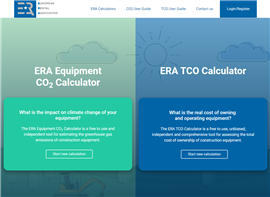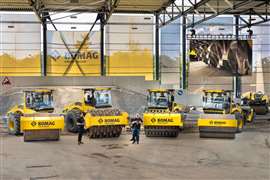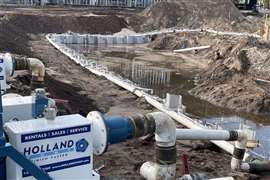Read this article in French German Italian Portuguese Spanish
Navigating uncertainty: how the world’s biggest construction equipment OEMs found Q1 2025
05 May 2025
With Q1 reporting season in full swing, some of the world’s largest construction equipment manufacturers have been giving their first major financial updates for 2025. Lucy Barnard finds out what they said.
 Image: Adobe Stock
Image: Adobe Stock
What a start to 2025 it has been! Above all, the year so far has been dominated by Donald Trump’s import tariffs - many of which have now been paused - which for lots of manufacturers have made an already challenging year even harder to navigate.
With Q1 reporting season now in full swing, OEMs are providing their first major financial updates for the year to investors, explaining how they are coping with difficult market conditions and what measures they are putting in place to mitigate the impact of tariffs.
International Rental News rounded up some of the biggest:
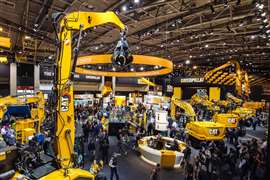 Caterpillar’s vast indoor stand proved to be one of the major attractions for visitors to the exhibition (Image: Ervin Bedeli)
Caterpillar’s vast indoor stand proved to be one of the major attractions for visitors to the exhibition (Image: Ervin Bedeli)
Caterpillar
Performance so far: In its Q1 2025 financials, published on 30 April, Caterpillar, the world’s largest construction equipment manufacturer, reported that sales for its Construction Industries segment were US$5.184 billion in the first quarter of 2025, a decrease of $1.240 billion, or 19% compared with the first quarter of 2024.
The US-based OEM said that this decrease was primarily due to lower sales volume of $820 million and unfavourable price realisation of $355 million.
Outlook for 2025: Caterpillar predicts that even taking into account the impact of current tariffs, full year sales will only be slightly down on the previous year. The company said it remained cautiously optimistic that a trade deal would be struck with China and said it remained in line to meet expectations.
The impact of US tariffs: Caterpillar said that before the tariffs were introduced it had upgraded previous forecasts for 2025 sales and revenues to be roughly the same as the previous year. However, taking into account levels of tariffs as of 29 April, it said it expected sales and revenues to be down slightly compared with the previous year and in line with previous expectations.
The company said it expected an additional costs of $250 million to $350 million in the second quarter of the year from tariffs (after initial mitigation actions and cost controls). It said it had already put in place some mitigation measures such as slowing some inbound shipments and reducing discretionary spending and travel, but it planned to wait to see how the situation evolves before implementing more lasting changes, such as moving the sourcing of components.
Komatsu
Performance so far: In its full year results for the 2024 financial year which Japanese construction equipment manufacturer Komatsu published on 28 April, the company reported a solid set of figures. Net sales rose 6.2% in the year ended 31 March 2025, to 4.1 trillion yen (US$28.5 billion) and operating income rose 8.2% to 657.1 billion yen (US$4.6 billion).
Outlook for 2025: Komatsu says that a combination of the Japanese yen rising again after record lows the previous year and the introduction of US trade tariffs means it expects 2025 to be altogether a tougher prospect. The company predicts net sales of construction, mining and utility equipment to be down 9.4% in 2025 to 3.4 trillion yen (US$23.8 billion). Segment profit to fall 28.5% to 428 billion yen (US$3 billion).
Demand: Komatsu said that it had seen a decline in demand from rental companies in both Japan (where sales fell 3.1% compared with the previous year) and in North America where sales nonetheless increased 3.4% bolstered by increased sales of mining equipment. The company also noted a drop in demand for construction equipment in the major European markets where sales fell 1.4% and the Middle East – especially Saudi Arabia – where sales fell 2.5%. Nonetheless, Komatsu said demand increased significantly in China, boosting sales 14.2% compared with the previous year and in Asia, sales increased 14.1%, bolstered by steady demand in Indonesia.
The impact of US tariffs: Based on tariff rates set by the US as of 24 April, Komatsu reckons that its direct increased US tariff costs will be 78 billion yen (US$550 million). However, when it takes into consideration the impact the charges will have on sales, it estimates it will take a hit to sales of 50 billion yen (US$350 million) and a 15 billion yen (US$110 million) decline in profit.
The company said it had taken immediate measures to mitigate the impact of tariffs such as bypassing the US when it exports from Japan to Canada. The company said it was considering taking further steps such as changing sources globally.
Sany
Performance so far: China-based Sany released its full year 2024 results on 30 April reporting a 6% sales increase from 2023 to US$10.88 billion. Net profit attributable to shareholders increased 31.98% to US$0.84 billion. The OEM said that international sales, which account for 64% of core business revenue, grew 12 % compared with the previous year.
Outlook for 2025: Sany said in 2025 it planned to deepen technological innovation, strengthen risk management and enhance governance efficiency.
Demand: The growth of international markets was primarily driven by the Asia and Australia regions, whose reported revenue was $2.88 billion, a 15.47% year-on-year increase. The African market saw revenue jump by 44% to $0.75 billion.
The impact of US tariffs: Sany, which has manufacturing facilities countries including India, Brazil, Germany and the USA, said it was prioritising globalisation efforts and had established production localised teams, production bases, R&D centres, marketing and service networks, enabling coordinated and efficient operations across all regions.
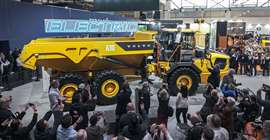 The Volvo A30 Electric was unveiled for the first time at Bauma 2025. Photo: Volvo CE
The Volvo A30 Electric was unveiled for the first time at Bauma 2025. Photo: Volvo CE
Volvo Construction Equipment
Performance so far: Volvo reported that global sales for Q1 2025 stood at US$2.21 billion, a decline of 8% compared with the same period a year ago. When adjusted for currency movements, net sales of machines decreased by 10%.
Outlook for 2025: Volvo CE said that “increased geopolitical and market uncertainty” were driving declines in Europe and North America.
The impact of US tariffs: The company has announced no plans to change direction and says it remains committed to bolstering its zero emissions machine ranges. It adds that it produces machines across its entire portfolio at its US manufacturing bases.
JLG (Oshkosh Corp)
Performance so far: JLG’s Q1 2025 sales fell -22.7%, or $280.4 million, to $957.1 million, a sharp decline from 2024’s Q1 sales of $1.24 billion. Operating income for JLG was also significantly impacted, plunging -50.5% to $103.1 million, or 10.8% of sales, compared to $208.1 million, or 16.8%, a year earlier.
For the three months ending March 31, JLG’s aerial work platform sales totaled $450.8 million, down -23.7% from $591.0 million year-over-year. Telehandler sales also took a massive hit, down more than -35% to $244.5 million from last year’s $373.4 million. Oshkosh noted, however, JLG’s backlog remained stable at $1.8 billion, consistent with Q4 2024 levels, though down significantly (-57%) from March 2024.
Demand: According to parent company Oshkosh, the downturn was driven primarily by lower sales volume in North America, which the company reported in the previous quarter, had been experiencing “softening demand.”
The impact of US tariffs: Oshkosh chief executive John Pfeifer said that the impact of tariffs could reduce full year earnings by US$1 a share but internal cost-cutting efforts could claw back up to $0.50 a share. JLG said “nearly all” the machines it sells in the US are built in the country and that it was working with its global supply chain to mitigate potential impacts.
“We’re generally adverse to tariffs on steel,” said Mahesh Narang, president of JLG, in an exclusive interview with Rental Briefing lst month. “But we buy most of our steel locally — in the U.S., from U.S. mills; in Europe and China, from local suppliers. Our long-term contracts help, and our customers understand commodity fluctuations. If prices change, we adjust accordingly.”
Haulotte
Performance so far: Haulotte said Q1 turnover fell 18% compared with the same period a year earlier to €131 million. Sales were down 6% in Europe, 41% down in Asia Pacific and 27% down in North America. “The slowdown in the global aerial work platform market that started in the second half of 2023, has continued in early 2025,” the company said.
Demand: In Europe, despite the decrease in the European Central Bank’s key interest rates, major rental players remain cautious with their investments resulting in a 6% decline in Haulotte’s sales compared to the first quarter of 2024, said the company. In Asia Pacific, the group experienced a 41% drop in revenue, reflecting a sharp slowdown in key markets at the beginning of the year. In North America, the downward trend observed in the second half of 2024 has persisted, with most rental companies maintaining a wait-and-see approach.
Outlook for 2025: Due to limited visibility across all markets, the group said it was unable to forecast sales and operating margins for 2025 but would do so as soon as conditions permitted.
The impact of US tariffs: Haulotte chief executive Alexandre Saubot has said that the company plans to wait until the market stabilises before it makes any major investment decisions in the US.
Manitou
Performance so far: In its Q1 results for 2025, Manitou reported a drop in net sales of 12% to €600 million compared with the same period a year ago – something it said was in line with expectations made last year.
Demand: Michel Denis, president & chief executive officer, said that in the North American market, the company’s business plan has to contend with a growing wait-and-see attitude among customers and a very gradual ramp-up of operations. On the other hand, European markets turned out to be more dynamic than expected. He said the shortening of delivery times is enabling customers to order at short deadlines - a phenomenon amplified by the low visibility of markets. As a result, Manitou’s order book now represents around 9 months of activity.
Outlook for 2025: Manitou said revenues and operating profits were forecasted to be stable this year The company said its order intake was higher than the previous quarter and on the rise.
The impact of US tariffs: Manitou said it had taken steps to limit the impact of any tariffs set by the US Trump administration.
Zoomlion
Performance so far: China-based Zoomlion reported its Q1 2025 results on 30 April, reporting operating income of RMB12.12 billion (US$1.7 billion), up 2.9% on the same period the previous year. Net profit attributable to the parent company rose 54% to RMB1.4 billion (US$196 million).
Demand: International revenue increased 15.2% from the previous year to RMB 6.5 billion (US$893 million) accounting for 54.2% of revenue.
Outlook for 2025: The company said it was well positioned to accelerate growth and enhance its global leadership in 2025.
Impact of US tariffs: On April 10, Zoomlion reported that the USA’s policy of imposing “reciprocal tariffs” on China has very limited direct impact on the company. The revenue from the USA market accounts for a very low proportion of the company’s total revenue, with the USA market accounting for less than 1% of the total revenue in 2024. The amount of parts directly imported from the USA is very low, approximately RMB16 million (US$2.2 million) in 2024, which accounts for less than 0.05% of the company’s cost of goods sold for that year.
CNH Industrial
Performance so far: In its Q1 financials, published on 1 May, CNH said consolidated revenues were 21% down on a year ago at US$3.8 billion while net income was down 64% US$132 million. The company said the results reflected “market headwinds”.
Demand: Overall demand decreased by 11% in North America, 9% in Europe, the Middle East, and Africa (EMEA), and 1% in South America. Conversely, demand increased by 7% in the Asia Pacific region.
Outlook for 2025: The company forecasts that global retail sales in the agriculture and construction equipment markets will be lower in 2025 compared to 2024.
Impact of US tariffs: The company says that it is assessing various potential global trade scenarios. The uncertainties associated with these scenarios - such as the magnitude and duration of tariffs imposed, responses from U.S. trading partners, and their impact on our end customers.
STAY CONNECTED



Receive the information you need when you need it through our world-leading magazines, newsletters and daily briefings.
CONNECT WITH THE TEAM









